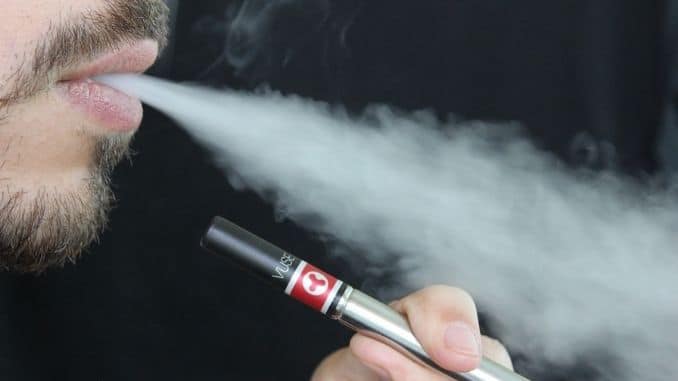
As of 2018 and according to the Centers for Disease Control and Prevention (CDC), about 14 out of every 100 adults in the United States aged 18 years or older currently smoked cigarettes — an estimated 34.2 million adults.
Cigarette smoking is the leading cause of preventable disease and death, accounting for more than 480,000 deaths every year or about one in five deaths.
The good news is that the number of people smoking has declined during the past decade. Between 2005 and 2018, it went down from 20.9 percent to 13.7 percent. Fewer people are lighting up and more are working on quitting.
It’s not easy to stop smoking, however, as anyone who’s tried it will tell you. In a 2016 study on the issue, researchers found that the estimated average number of quit attempts expected before a person was able to quit for good ranged from six to 30 times.
You can imagine, then, how many smokers felt when e-cigarettes came onto the U.S. market in 2007. Back then, these vaporizing devices were hailed as being a much safer alternative to traditional cigarettes. Even better, they were said to help people quit smoking.
The e-cigarette industry enjoyed wide-ranging success for years, with companies earning millions of dollars. Then, things started to change.
During the past year, e-cigarettes have been associated with many reports of potential health problems, illnesses and exposure to toxic substances. The news has left some smokers confused. Are e-cigarettes safer than traditional cigarettes? If you’re trying to quit, should you try vaping or is it just as dangerous?

What Are E-cigarettes?
E-cigarettes are electronic devices that run on a lithium-ion battery, much like the one that runs your cellphone or tablet. They come in many shapes and sizes and include a liquid solution that contains nicotine and other chemicals, often including flavorants.
When you turn an e-cigarette on, it heats the liquid solution, creating a vapor that you then inhale. When you draw in a breath, all of the components of the liquid solution go into your lungs in the form of an aerosol.
E-cigarettes are known by other names, including the following:
- E-cigs
- E-hookahs
- Mods
- Vape pens
- Vapes
- Tank systems
- Electronic nicotine delivery systems (ENDS)
How Do the Ingredients in E-cigarettes Compare to Those in Traditional Cigarettes?
The main difference between traditional and e-cigarettes is that traditional products contain tobacco while vaping products don’t.
When you light up a traditional cigarette, you burn the dried tobacco leaves. According to the American Lung Association (ALA), this creates more than 7,000 chemicals. At least 69 of these are toxic or known to cause cancer, heart disease, lung disease and other health problems. Some of the most dangerous chemicals include:
- Formaldehyde
- Lead
- Arsenic
- Ammonia
- Benzene
- Carbon monoxide
- Nitrosamines
- Polycyclic aromatic hydrocarbons (PAHs)
- Tar
- Toluene
This is why so many people thought that e-cigarettes were a safer alternative to traditional cigarettes — they don’t contain tobacco. That, in itself, would appear to reduce the number of chemicals users are exposed to significantly.
Early research seemed to support this point of view. In a 2017 study, scientists compared traditional smokers to vapers and found that the use of e-cigarettes was associated with substantially reduced levels of measured carcinogens and toxins compared with smoking traditional cigarettes.
In a 2018 study, researchers came to a similar conclusion — exclusive use of e-cigarettes seemed to result in exposure to toxicants at lower levels than cigarette smoking.
Those using e-cigarettes are exposed to toxins too. However, which brings us to the next issue—what are the dangerous chemicals in e-cigarettes?
Scientists are still looking into this. Since e-cigarettes are fairly new on the market, compared to traditional cigarettes, we still have a lot to learn. Here’s what we know so far.
Studies have identified a wide variety of chemicals in the cartridges, refill solutions and aerosols of e-cigarettes. In a 2015 study, scientists found about 60 to 70 compounds in each liquid tested, whereas a 2016 study identified 113 chemicals in 50 brands of liquids.
There are even more compounds in the aerosols than in the liquid solutions because some chemicals are generated during the vaporization process. In one study of a single product, scientists found 18 additional compounds in the aerosol than in the solution.
Some of the potential chemicals in e-cigarette solutions and aerosol include:
- Solvent carriers (propylene glycol and glycerol)
- Nitrosamines
- Aldehydes
- Ultrafine particles that can be inhaled deep into the lungs
- Flavorings
- Volatile organic compounds (VOCs)
- Heavy metals like nickel, tin and lead
- Polycyclic aromatic hydrocarbons (PAHs)
- Nicotine impurities
Many of these substances are known to be toxic, carcinogenic and/or to cause respiratory and cardiac disease. The U.S. Food and Drug Administration (FDA) has pointed out that e-cigarettes contain detectable levels of known carcinogens and toxins, including a toxic compound found in antifreeze.
Another study looked at 42 e-cigarette liquid cartridges and found that they contained formaldehyde, a known carcinogen. Several of the cartridges contained formaldehyde at much higher levels than the Environmental Protection Agency (EPA) recommends for humans.
As to how these compare to the chemicals in traditional cigarettes, it’s unclear. Although some studies published a few years ago seemed to show that e-cigarettes exposed users to fewer chemicals, new research suggests that it may not be that clear-cut.
Part of the problem is that e-cigarettes produce an aerosol, which leads to the chemicals being absorbed deep into the lungs. There, they can irritate the bronchi, cause an increase in blood pressure and heart rate, restrict the arteries and compromise blood flow. The vapor can also cause inflammation in the mouth, leading to gum disease and delay wound healing, leading to the telltale “smoker’s cough.”
This problem is what led to the recent epidemic of e-cigarette product use associated with lung injury (EVALI)—a dangerous condition that’s affected thousands of people across the country.
E-cigarette Related Lung Disease Attacks Thousands
In the summer of 2019, a strange lung illness broke out across the country, sending people to the hospital and even killing some patients. The only thing the illnesses had in common was that every patient had a history of using e-cigarettes.
The CDC later discovered that most, but not all, of the patients were using e-cigarettes containing tetrahydrocannabinol (THC), the mind-altering compound in marijuana. It also identified vitamin E acetate as a chemical of concern, noting that this substance was found in all samples of lung fluid tested from patients with EVALI.
Vitamin E acetate is often used in e-cigarette solutions with THC. Although it’s perfectly safe when taken in supplements or used in skin care, when inhaled deeply into the lungs, it can cause irritation and inflammation.
The CDC and FDA are working together with state health departments to figure out what’s causing these illnesses. They aren’t ready to name vitamin E acetate as the culprit in every case just yet. However, the research does show that a “harmless” ingredient can cause dangerous lung injuries when inhaled in a vapor. As of December 3, 2019, nearly 2,300 people had developed EVALI and 48 had died from it.
Can Vaping Help You Quit Smoking?
When e-cigarettes first came on the market, manufacturers advertised them heavily as a way to help smokers quit smoking. But do they work?
Again, we just don’t know. Although early studies suggested that they might help smokers quit, more recent research shows that what often happens is that smokers end up using e-cigarettes and traditional cigarettes together.
In a 2019 study, researchers found that a year after starting e-cigarettes, nearly half of the participants were still smoking and vaping, whereas 5 percent were only vaping and 7 percent had quit both products.
An earlier analysis of many studies also found that, although quitting smoking was a common marketing claim used by e-cigarette manufacturers, the overall conclusion from the studies was that e-cigarette use is not associated with smoking cessation in the real world.
This analysis contained only a small number of studies as there haven’t been that many yet completed. Perhaps the main question is: Why trade one dangerous substance for another? The healthiest option is to quit altogether, especially considering the growing concern about the dangers associated with e-cigarettes.
There is currently good evidence, for instance, that vaping can increase your risk of heart attack as well as lung illness and, potentially, cancer. In a 2019 study, researchers found that e-cigarette use was associated with an increased risk of having a heart attack and that the effect of using them on the heart was similar to using traditional cigarettes. Using both at the same time was riskier than using either alone.
As for whether e-cigarettes truly are safer than traditional cigarettes when it comes to cancer, we still can’t be sure about that, either. It takes cancer years to develop and e-cigarettes have been on the market for slightly more than a decade. We need more time to conduct long-term studies on e-cigarette use before we know how they compare in their cancer-causing potential.
The American Heart Association recommends that smokers who want to quit should use proven quitting methods rather than e-cigarettes. These include nicotine replacement therapy options like skin patches, chewing gum, lozenges, nasal sprays and inhalers, which do not expose users to any dangerous toxins ― other than nicotine ― or carcinogens.
Talk to Your Teens About E-cigarettes
The U.S. Surgeon General recently warned that e-cigarette use was contributing to a rising epidemic of vaping among middle school and high school students. Between 2011 and 2015, e-cigarette use among middle school and high school students increased by 900 percent.
There is a great lack of awareness among teens about the dangers of e-cigarettes. The JUUL e-cigarette, in particular, which has gained popularity among teens because of its sleek design and yummy flavors, has been found in studies to deliver significantly more nicotine than other e-cigarettes, resulting in a faster and fiercer addiction.
Teens who use e-cigarettes are also more likely to use traditional e-cigarettes in the future. The CDC recommends that parents tell their kids about the risks. In addition to everything mentioned here, it’s also important for teens to know that using products with nicotine before the age of 25 can affect the developing brain, resulting in problems with memory, attention and learning down the road.
For help getting into a healthier eating style, make sure you check out The Best Foods that Rapidly Slim & Heal in 7 Days, here!
.






